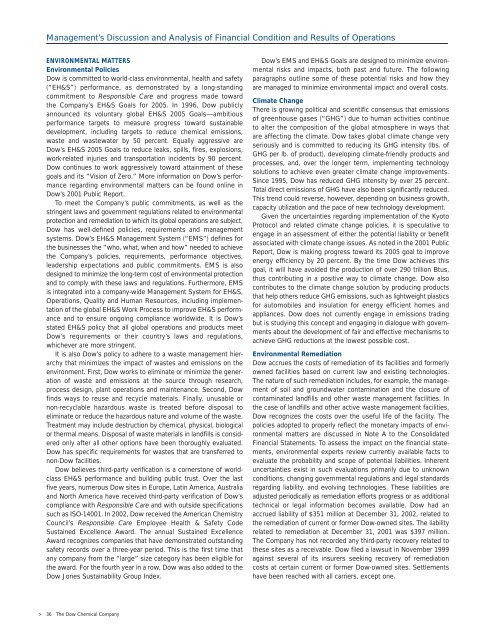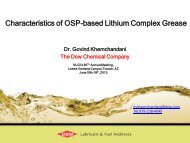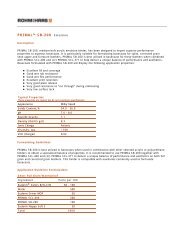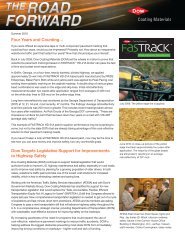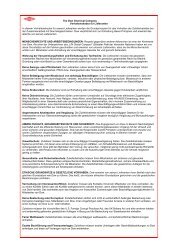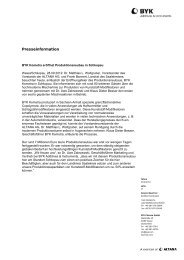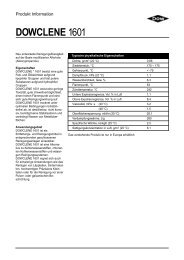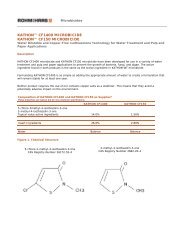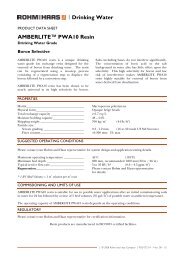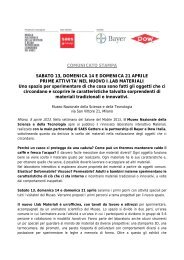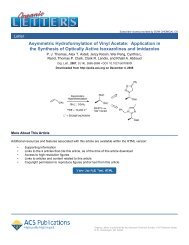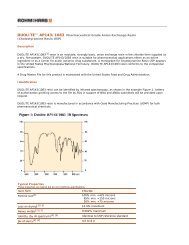Focus - The Dow Chemical Company
Focus - The Dow Chemical Company
Focus - The Dow Chemical Company
You also want an ePaper? Increase the reach of your titles
YUMPU automatically turns print PDFs into web optimized ePapers that Google loves.
Management’s Discussion and Analysis of Financial Condition and Results of Operations<br />
ENVIRONMENTAL MATTERS<br />
Environmental Policies<br />
<strong>Dow</strong> is committed to world-class environmental, health and safety<br />
(“EH&S”) performance, as demonstrated by a long-standing<br />
commitment to Responsible Care and progress made toward<br />
the <strong>Company</strong>’s EH&S Goals for 2005. In 1996, <strong>Dow</strong> publicly<br />
announced its voluntary global EH&S 2005 Goals—ambitious<br />
performance targets to measure progress toward sustainable<br />
development, including targets to reduce chemical emissions,<br />
waste and wastewater by 50 percent. Equally aggressive are<br />
<strong>Dow</strong>’s EH&S 2005 Goals to reduce leaks, spills, fires, explosions,<br />
work-related injuries and transportation incidents by 90 percent.<br />
<strong>Dow</strong> continues to work aggressively toward attainment of these<br />
goals and its “Vision of Zero.” More information on <strong>Dow</strong>’s performance<br />
regarding environmental matters can be found online in<br />
<strong>Dow</strong>’s 2001 Public Report.<br />
To meet the <strong>Company</strong>’s public commitments, as well as the<br />
stringent laws and government regulations related to environmental<br />
protection and remediation to which its global operations are subject,<br />
<strong>Dow</strong> has well-defined policies, requirements and management<br />
systems. <strong>Dow</strong>’s EH&S Management System (“EMS”) defines for<br />
the businesses the “who, what, when and how” needed to achieve<br />
the <strong>Company</strong>’s policies, requirements, performance objectives,<br />
leadership expectations and public commitments. EMS is also<br />
designed to minimize the long-term cost of environmental protection<br />
and to comply with these laws and regulations. Furthermore, EMS<br />
is integrated into a company-wide Management System for EH&S,<br />
Operations, Quality and Human Resources, including implementation<br />
of the global EH&S Work Process to improve EH&S performance<br />
and to ensure ongoing compliance worldwide. It is <strong>Dow</strong>’s<br />
stated EH&S policy that all global operations and products meet<br />
<strong>Dow</strong>’s requirements or their country’s laws and regulations,<br />
whichever are more stringent.<br />
It is also <strong>Dow</strong>’s policy to adhere to a waste management hierarchy<br />
that minimizes the impact of wastes and emissions on the<br />
environment. First, <strong>Dow</strong> works to eliminate or minimize the generation<br />
of waste and emissions at the source through research,<br />
process design, plant operations and maintenance. Second, <strong>Dow</strong><br />
finds ways to reuse and recycle materials. Finally, unusable or<br />
non-recyclable hazardous waste is treated before disposal to<br />
eliminate or reduce the hazardous nature and volume of the waste.<br />
Treatment may include destruction by chemical, physical, biological<br />
or thermal means. Disposal of waste materials in landfills is considered<br />
only after all other options have been thoroughly evaluated.<br />
<strong>Dow</strong> has specific requirements for wastes that are transferred to<br />
non-<strong>Dow</strong> facilities.<br />
<strong>Dow</strong> believes third-party verification is a cornerstone of worldclass<br />
EH&S performance and building public trust. Over the last<br />
five years, numerous <strong>Dow</strong> sites in Europe, Latin America, Australia<br />
and North America have received third-party verification of <strong>Dow</strong>’s<br />
compliance with Responsible Care and with outside specifications<br />
such as ISO-14001. In 2002, <strong>Dow</strong> received the American Chemistry<br />
Council’s Responsible Care Employee Health & Safety Code<br />
Sustained Excellence Award. <strong>The</strong> annual Sustained Excellence<br />
Award recognizes companies that have demonstrated outstanding<br />
safety records over a three-year period. This is the first time that<br />
any company from the “large” size category has been eligible for<br />
the award. For the fourth year in a row, <strong>Dow</strong> was also added to the<br />
<strong>Dow</strong> Jones Sustainability Group Index.<br />
> 36 <strong>The</strong> <strong>Dow</strong> <strong>Chemical</strong> <strong>Company</strong><br />
<strong>Dow</strong>’s EMS and EH&S Goals are designed to minimize environmental<br />
risks and impacts, both past and future. <strong>The</strong> following<br />
paragraphs outline some of these potential risks and how they<br />
are managed to minimize environmental impact and overall costs.<br />
Climate Change<br />
<strong>The</strong>re is growing political and scientific consensus that emissions<br />
of greenhouse gases (“GHG”) due to human activities continue<br />
to alter the composition of the global atmosphere in ways that<br />
are affecting the climate. <strong>Dow</strong> takes global climate change very<br />
seriously and is committed to reducing its GHG intensity (lbs. of<br />
GHG per lb. of product), developing climate-friendly products and<br />
processes, and, over the longer term, implementing technology<br />
solutions to achieve even greater climate change improvements.<br />
Since 1995, <strong>Dow</strong> has reduced GHG intensity by over 25 percent.<br />
Total direct emissions of GHG have also been significantly reduced.<br />
This trend could reverse, however, depending on business growth,<br />
capacity utilization and the pace of new technology development.<br />
Given the uncertainties regarding implementation of the Kyoto<br />
Protocol and related climate change policies, it is speculative to<br />
engage in an assessment of either the potential liability or benefit<br />
associated with climate change issues. As noted in the 2001 Public<br />
Report, <strong>Dow</strong> is making progress toward its 2005 goal to improve<br />
energy efficiency by 20 percent. By the time <strong>Dow</strong> achieves this<br />
goal, it will have avoided the production of over 290 trillion Btus,<br />
thus contributing in a positive way to climate change. <strong>Dow</strong> also<br />
contributes to the climate change solution by producing products<br />
that help others reduce GHG emissions, such as lightweight plastics<br />
for automobiles and insulation for energy efficient homes and<br />
appliances. <strong>Dow</strong> does not currently engage in emissions trading<br />
but is studying this concept and engaging in dialogue with governments<br />
about the development of fair and effective mechanisms to<br />
achieve GHG reductions at the lowest possible cost.<br />
Environmental Remediation<br />
<strong>Dow</strong> accrues the costs of remediation of its facilities and formerly<br />
owned facilities based on current law and existing technologies.<br />
<strong>The</strong> nature of such remediation includes, for example, the management<br />
of soil and groundwater contamination and the closure of<br />
contaminated landfills and other waste management facilities. In<br />
the case of landfills and other active waste management facilities,<br />
<strong>Dow</strong> recognizes the costs over the useful life of the facility. <strong>The</strong><br />
policies adopted to properly reflect the monetary impacts of environmental<br />
matters are discussed in Note A to the Consolidated<br />
Financial Statements. To assess the impact on the financial statements,<br />
environmental experts review currently available facts to<br />
evaluate the probability and scope of potential liabilities. Inherent<br />
uncertainties exist in such evaluations primarily due to unknown<br />
conditions, changing governmental regulations and legal standards<br />
regarding liability, and evolving technologies. <strong>The</strong>se liabilities are<br />
adjusted periodically as remediation efforts progress or as additional<br />
technical or legal information becomes available. <strong>Dow</strong> had an<br />
accrued liability of $351 million at December 31, 2002, related to<br />
the remediation of current or former <strong>Dow</strong>-owned sites. <strong>The</strong> liability<br />
related to remediation at December 31, 2001 was $397 million.<br />
<strong>The</strong> <strong>Company</strong> has not recorded any third-party recovery related to<br />
these sites as a receivable. <strong>Dow</strong> filed a lawsuit in November 1999<br />
against several of its insurers seeking recovery of remediation<br />
costs at certain current or former <strong>Dow</strong>-owned sites. Settlements<br />
have been reached with all carriers, except one.


